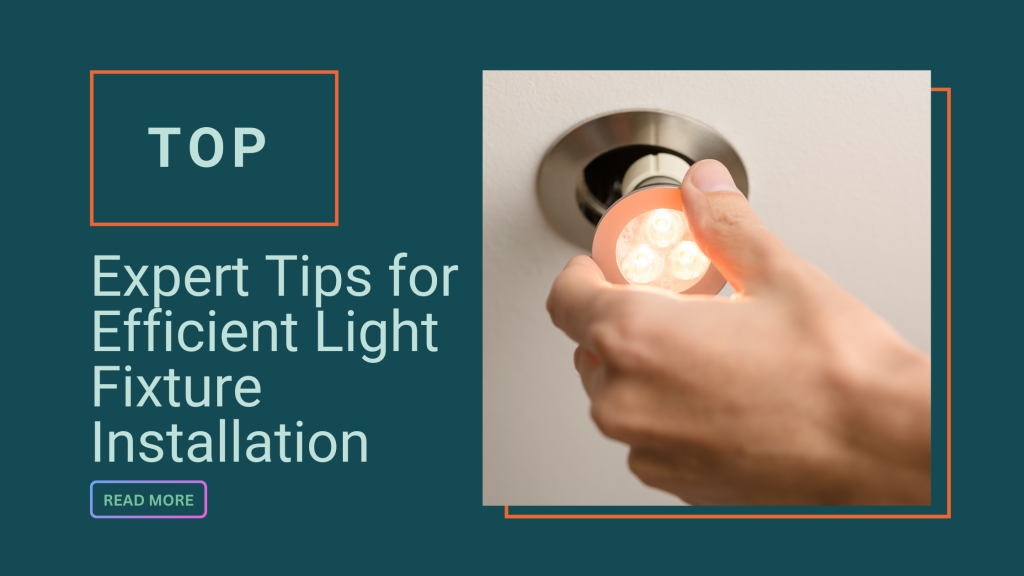Introduction to Light Fixture Installation
Lighting is one of the most important aspects of any home or office. The right fixture not only brightens up a room but also enhances its overall style and mood. From ceiling chandeliers and pendant lights to wall sconces and recessed lighting, each fixture requires careful handling and proper setup. This is where light fixture installation becomes essential.
Many homeowners try to learn how to light fixture installation on their own, thinking it is a simple task. While replacing a basic fixture may appear straightforward, electrical work involves certain complexities. Installing a new fixture may require wiring adjustments, mounting brackets, or compatibility checks with your existing electrical system. That is why opting for a professional light fixture installation is often the best choice. Experts ensure that fixtures are installed safely, efficiently, and in a way that complements the design of your space.
Tools and Materials Required
Before beginning the process, having the right tools and materials is critical. Proper preparation ensures the job is completed efficiently and reduces the risk of mistakes.
Common tools used for light fixture installation include:
- Voltage tester (to ensure wires are not live)
- Screwdrivers (both flathead and Phillips)
- Wire strippers and cutters
- Electrical tape
- Pliers
- Power drill with bits
- Ladder or step stool
- Safety goggles and gloves
Materials required often include:
- New light fixture with mounting hardware
- Electrical box (if not already installed)
- Wire nuts and connectors
- Light bulbs (LED, incandescent, or CFL as needed)
- Anchors and screws for heavy fixtures
- Circuit labels (to mark breakers during installation)
A professional brings specialized tools, high-quality connectors, and advanced safety equipment, making the installation process much smoother.
Step-by-Step Instructions
Step 1: Turn Off the Power
Always begin by switching off the circuit breaker that controls the light fixture. Use a voltage tester to confirm that no electricity is flowing to the wires. Safety comes first in any electrical project.
Step 2: Remove the Old Fixture
If replacing an existing fixture, unscrew the mounting plate and carefully detach the fixture. Support it while disconnecting the wires. Remove wire nuts and gently separate the connections, ensuring no damage to the existing electrical box.
Step 3: Inspect the Electrical Box
Check that the electrical box is securely mounted and rated to support the weight of the new fixture. Heavy chandeliers or ceiling fans may require reinforced boxes or brackets.
Step 4: Connect the Wires
Match the wires from the new fixture with the ones in the ceiling: typically, black (hot) connects to black, white (neutral) to white, and green or bare copper (ground) to the ground wire or screw. Twist the wires together with connectors and wrap them with electrical tape for added safety.
Step 5: Mount the Fixture
Attach the mounting bracket to the electrical box, then secure the fixture according to the manufacturer’s instructions. Ensure that the fixture is level and firmly anchored. For larger or heavier fixtures, it may take two people to hold and mount the piece properly.
Step 6: Install the Bulbs and Covers
Insert the recommended light bulbs and attach any glass shades, covers, or decorative parts included with the fixture.
Step 7: Restore Power and Test
Switch the circuit breaker back on and test the fixture. Ensure it works correctly, with no flickering, buzzing, or unusual issues.
Safety Tips and Best Practices
Electrical projects can be dangerous without proper precautions. Following these best practices ensures safe and efficient installation:
- Always cut power at the breaker box before working on wiring.
- Use the correct electrical box for the fixture’s weight and size.
- Do not overload circuits by connecting too many fixtures to one line.
- Check local codes for electrical work compliance.
- Avoid working alone when installing heavy or complex fixtures.
- Use insulated tools to reduce the risk of electrical shock.
- Call a professional if you encounter aluminum wiring, outdated connections, or unclear instructions.
Choosing a professional light fixture installation service eliminates many of these risks. Licensed electricians know how to handle complex wiring, ensure compliance with building codes, and guarantee safe, long-lasting results.
Final Thoughts and Maintenance Tips
Proper lighting transforms a space, making it more inviting, functional, and stylish. While DIY projects can be rewarding, electrical work should never be taken lightly. A skilled light fixture installation expert ensures that your fixture is safely and beautifully mounted without hassle.
To keep your fixtures working efficiently, consider these maintenance tips:
- Clean regularly: Dust and dirt buildup reduces brightness and efficiency.
- Check wiring annually: Loose connections can cause flickering or overheating.
- Use recommended bulbs: Avoid exceeding the maximum wattage indicated on the fixture.
- Replace faulty parts immediately: If you notice unusual buzzing, flickering, or heat, address the issue promptly.
- Upgrade when necessary: Modern LED fixtures save energy and last longer than traditional options.
In conclusion, while learning how to light fixture installation can help with minor projects, investing in professional light fixture installation provides peace of mind, efficiency, and guaranteed safety. With the right approach, you can enjoy beautiful, functional lighting that enhances your living space for years to come.



